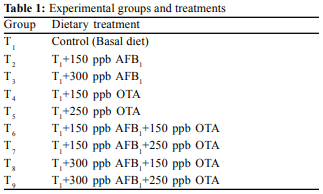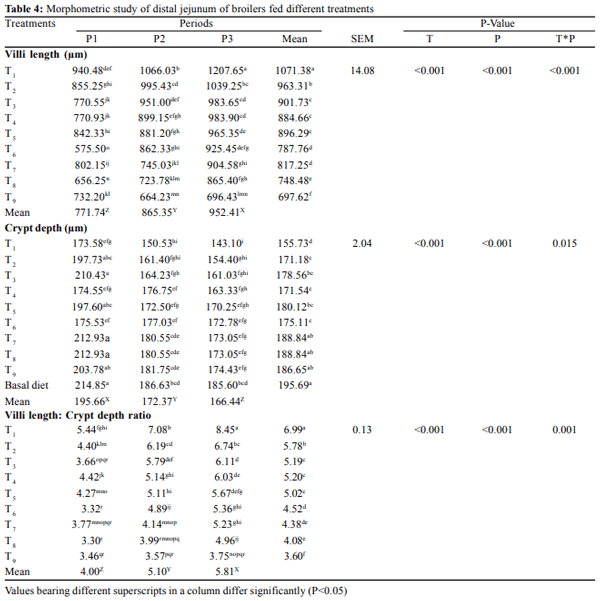Effect of aflatoxin, ochratoxin and their interaction on growth performance, immunity and jejunal morphometry of broiler chickens
The present study was conducted to evaluate the impact of aflatoxin, ochratoxin and their interaction on growth performance, immunity and gut health of broiler chickens. Day-old broiler chicks (n=288) were divided into 9 treatment groups (T1 : control (basal diet); T2 : T1 +150 ppb AFB1 ; T3 : T1 +300 ppb AFB1 ; T4 : T1 +150 ppb OTA; T5 : T1 +250 ppb OTA; T6 : T1 +150 ppb AFB1 +150 ppb OTA; T7 : T1 +150 ppb AFB1 +250 ppb OTA; T8 : T1 +300 ppb AFB1 +150 ppb OTA; T9 : T1 +300 ppb AFB1 +250 ppb OTA). Each diet was fed to 4 replicated groups of 8 birds each from 0 to 42 days of age. The overall body weight gain (BWG) of broilers in control group (T1 ) was higher (P<0.05) than those of all other treatment groups. The BWG in 150 ppb aflatoxin B1 fed group (T2 ) was higher(P<0.05) than that of 150 ppb OTA fed group (T4 ), indicating that OTA was almost two times more toxic than AFB1 in reducing the BWG of broiler chickens. Significantly (P<0.05) lower FI was observed in T9 group compared to all other dietary treatments. Feed contaminated with AFB1 and OTA simultaneously caused severe deterioration of feed conversion efficiency compared to individual mycotoxin. The CMI and humoral immune response was higher (P<0.05) in control group and gradually decreased in other treatment groups. The mean villus length: crypt depth ratio was highest in control group and decreased (P<0.05) in all other treatment groups. The villus length to crypt depth ratio value was lowest in 300 ppb AFB1 +250 ppb OTA fed group (T9 ) compared to all other treatments. It was concluded that co-contamination of aflatoxin and ochratoxin caused severe reduction in growth performance compared to individual mycotoxins and combine feeding of aflatoxin (300 ppb) and ochratoxin (250 ppb) led to the synergistic toxicity on body weight gain, feed intake, feed efficiency and immunity in broiler chickens.
Key words: Broiler, aflatoxin, ochratoxin, growth performance, immunity, morphometry.




Abaji, P.K. 2012. Efficacy of Saccharomyces cerevisiae and mannan oligosaccharides (MOS) in counteracting aflatoxicosis in broiler chickens. M.V.Sc. Thesis, Submitted to Deemed University, IVRI, Izatnagar.
Agawane, S.B. and Lonkar, P.S. 2004. Effect of probiotic containing Saccharomyces boulardiion experimental ochratoxicosis in broilers: hematobiochemical studies. Journal of Veterinary Science, 5: 359-67.
AOAC. 1995. Official Methods of Analysis. 15th edn. Association of Official Analytical Chemists, Washington, DC.
Applegate, T.J., Schatzmayr, G., Pricket, K., Troche, C. and Jiang, Z. 2009. Effect of aflatoxin culture on intestinal function and nutrient loss in laying hens.Poultry Science, 88: 1235– 41.
Campbell, M.L., May, J.D., Huff, W.E. and Doerr, J.A. 1983. Evaluation of immunity of young broiler chickens during simultaneous aflatoxicosis and ochratoxicosis. Poultry Science, 62: 2138-44.
Das, K. 2004. FAO- animal production and health division, Poultry sector country review.
Effat, M.M. 1989. Ochratoxin A and its effect on chicken immuneresponse. M. Sc. Thesis, Fac. Vet. Med. Cairo Univ., Egypt. pp 105.
Elaroussi, M.A., Mohamed, F.R., Elgendy, M.S., El Barkouky, E.M., Abdou, A.M. and Hatab, M.H. 2008. Ochratoxicosis in broiler chickens: Functional and histological changes in target organs. International Journal of Poultry Science, 75: 414–22.
El-Barkouky, E.M. and Abu-Taleb, A.M. 2008. The role of vitamin C in improving the performance of male broiler chickens feed ration contaminated with ochratoxin. Egyptian Journal of Applied Science, 23: 1-12.
El-Barkouky, E.M., Mohamed, F.R., Atta, A.M., Abu-Taleb, A.M., ElMenawey, M.A. and Hatab, M.H. 2010. Effect of saccharomyces cerevisiae and vitamin C supplementation on broiler performance subjected to ochratoxin A contamination. Egyptian Poultry Science, 30: 89-113.
Huff, W.E. and Doerr, J.A. 1981. Synergism between aflatoxin and ochratoxin A in broiler chickens. Poultry Science, 60: 550-55.
Huff, W.E., Kubena, L.F., Harvey, R.B. and Phillips, T.D. 1992. Efficacy of hydrated sodium calcium aluminosilicate to reduce the individual and combined toxicity of aflatoxin and ochratoxin A. Poultry Science, 71: 64-69.
Jahanian, E., Mahdavi, A.H., Asgary, S. and Jahanian, R. 2016. Effect of dietary supplementation of mannanoligosaccharides on growth performance, ilealmicrobial counts, and jejuna morphology in broiler chick sex posed to aflatoxins. Livestock Science, 190: 123–30.
Kubena, L.F., Harvey, R.B., Huff, W.E., Corrier, D.E., Philips, T.D. and Creger, C.R. 1988. Influence of ochratoxin A and deoxynivalenol on growing broiler chicks. Poultry Science, 67: 253-60.
Kubena, L.F., Harvey, R.B., Huff, W.E., Corrier, D.E., Philips, T.D. and. Rottinghaus, G.E. 1989. Influence of ochratoxin A and T-2 toxin singly and in combination on broiler chickens. Poultry Science, 68: 867-72.
Kubena, L.F., Harvey, R.B., Philips, T.D. and Huff, W.E. 1998. Modulation of aflatoxicosis in growing chickens by dietary addition of a hydrated sodium calcium aluminosilicate. Poultry Science, 67: 106.
Kubena, L.F., Harvey, R.B., Philips, T.D., Corrier, D.E. and Huff, W.E. 1990. Diminution of aflatoxicosis in growing chickens by dietary addition of a hydrated sodium calcium aluminosilicate. Poultry Science, 69: 727-35.
Kubena, L.F., Philips, T.D., Creger, C.R., Witzel, D.A. and Heidelbaugh, N.D. 1983.Toxicity of ochratoxin A and tannic acid to growing chicks. Poultry Science, 62: 1786-92.
Pons, D., Cucullu, A.P., Lee, L.S., Robertson, J.A. and Goldblatt, L.A. 1966. Determination of aflatoxins in agricultural products: Use of aqueous acetone for extraction. Journal of Analytical Chemistry, 49: 544-52.
Raju, M.V.L.N. and Devegowda, G. 2000. Influence of esterified glucomannan on performance and organ morphology, serum biochemistry and hematology in broilers exposed to individual and combined mycotoxicosisaflatoxin, ochratoxin and T-2 toxin. British Poultry Science, 41: 640-50.
Sawale, G.K., Gosh, R.C., Ravikanth, K., Maini, S. and Rekhe, D.S. 2009. Experimental mycotoxicosis in layer induced by ochratoxin A and its amelioration with herbomineral toxin binder toxiroak. International Journal of Poultry Science, 8: 798-803.
Sharma, M. 2013. Interaction of aflatoxicosis with methionine and zinc levels in diet of Broiler chickens. M.V.Sc. Thesis, Submitted to Deemed University, IVRI, Izatnagar.
Sharma, M., Singh, R., Mandal A.B. and Gupta, V.P. 2014. Efficacy of zinc in amelioration of aflatoxicosis in broiler chickens. Indian Journal of Animal Sciences, 84: 311-15.
Sharma, R.P. 1993 Immunotoxicity of mycotoxins. Journal of Dairy Science, 76: 892- 97.
Shotwell, O.L, Hesseltine, C.V., Stubblefield, R.D. and Sorenson, W.G. 1966. Production of aflatoxin on rice. Applied Microbiology, 14: 425-29.
Silambarasan, S., Singh, R. and Mandal, A.B. 2013.Evaluation of the ability of adsorbents to ameliorate the adverse effects of aflatoxin B1 in broiler chickens. Indian Journal of Animal Sciences, 83: 73- 77.
Singh, G.S.P., Chauhan, H.V.S., Jha, G.J. and Singh, K.K. 1990. Immunosuppression due to chronic ochratoxicosis in broiler chicks. Journal of Comparative Pathology, 103: 399-410.
Singh, M., Singh, R. and Mandal, A.B. 2016.Use of Saccharomyces cerevisiae to suppress the effects of ochratoxicosis in broiler chickens. Indian Journal of Animal Sciences, 86: 790–94.
Singh, R., Mandal, A.B. and Biswas, A. 2013.Efficacy of DLMethionine in amelioration of aflatoxicosis in coloured broiler chicken. Indian Journal of Animal Sciences,83: 1329- 34.
Singh, R., Mandal, A.B., Sharma, M. and Biswas, A. 2015. Effect of varying levels of dietary ochratoxin A on the performance of broiler chickens. Indian Journal of Animal Sciences, 85: 296-300.
Singh, R., Shrivastav, H.P. and Shrivastav, A.K. 2010. Mycotoxin contamination in maize as poultry feed. Indian Journal of Poultry Science, 45: 108-10.
Singh, R., Tyagi, P.K., Divya. and Sharma, M. 2013a . Ochratoxigenic potential of Aspergillus westerdijkiae NRRL 3174 under laboratory conditions. Indian Journal of Poultry Science, 45: 108-10.
Stoev, S.D., Steanov, M., Denev, S., Radic, B., Domijan, A.M. and Peraica, M. 2004. Experimental mycotoxicosis in chickens induced by ochratoxin A and penicillic acid and intervention with natural plant extracts. Veterinary Research Commnication, 28: 727-46.
Swamy, H.V.L.N., Shuaib, A. and Bhat, A. 2012. Fusariummycotoxins are widespread in South Asian feedstuff. Poultry World, pp 41-46.
Talapatra, S.K., Ray, S.C. and Sen, K.C. 1940. Estimation of phosphorus, choline, calcium, magnesium, sodium and potassium in feeding stuffs. Journal of Veterinary Science and Animal Husbandry, 10: 243-45.
Verma, J., Johri, T. S., Swain, B. K. and Ameena, S. 2004. Effect of graded levels of aflatoxin, ochratoxin and their combinations on the performance and immune response of broilers. British Poultry Science, 45: 512–18.
Yunus, A.W., Razzazi-Fazeli, E. and Bohm, J. 2011. Aflatoxin B1 in affecting broiler’s performance, immunity and gastrointestinal tract: A review of history and contemporary issues. Toxins, 3: 566-90.








